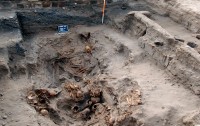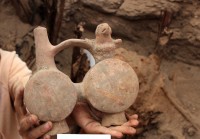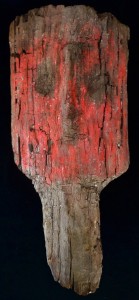 Archaeologists from the Université libre de Bruxelles (ULB) have discovered a huge intact tomb in the ancient religious center of Pachacamac, 20 miles southeast of Lima. Provisionally dated to around 1000 A.D., 200 years after the collapse of the Huari culture which first built the city and 450 years before the Inca Confederacy invaded the area, the oval tomb is 65 feet long and contains the remains of more than 70 people including a dozen infants.
Archaeologists from the Université libre de Bruxelles (ULB) have discovered a huge intact tomb in the ancient religious center of Pachacamac, 20 miles southeast of Lima. Provisionally dated to around 1000 A.D., 200 years after the collapse of the Huari culture which first built the city and 450 years before the Inca Confederacy invaded the area, the oval tomb is 65 feet long and contains the remains of more than 70 people including a dozen infants.
 The tomb was dug into the ground, then covered with a roof of reeds supported by carved tree trunks. The babies were found around the perimeter of the tomb with the heads pointing inward towards the center of the tomb. The main chamber is divided into two parts by a mud brick wall. More mummies and skeletons of men and women of all ages were found buried in fetal positions near the mud brick wall. They were buried with a wealth of around 100 grave goods: ceramic animals (dogs, guinea pigs) and vases, copper and gold alloy jewelry, gourds and wooden masks with faces painted on them known as “false heads.”
The tomb was dug into the ground, then covered with a roof of reeds supported by carved tree trunks. The babies were found around the perimeter of the tomb with the heads pointing inward towards the center of the tomb. The main chamber is divided into two parts by a mud brick wall. More mummies and skeletons of men and women of all ages were found buried in fetal positions near the mud brick wall. They were buried with a wealth of around 100 grave goods: ceramic animals (dogs, guinea pigs) and vases, copper and gold alloy jewelry, gourds and wooden masks with faces painted on them known as “false heads.”
Despite the material wealth buried with the people, the tomb does not appear to be royal. It’s more likely a family plot.
The team’s group of physical anthropologists, under the direction of Dr Lawrence Owens (University of London), have posited the possibility of a genetic relationship between many of the individuals, on the basis of certain morphological traits recorded in the skeletons. Certain of the individuals suffered mortal injuries, physical trauma or serious illness.
Previous work by the Ychsma Project has revealed the extensive presence of disease in the Pachacamac skeletal population, leading to the suggestion that the affected individuals had, as testified by Inca sources, travelled to the site in search of a cure: a form of Prehispanic Lourdes.
 It’s an incredible stroke of good fortune that a tomb of such advanced age was discovered untouched by Conquistadors, wars and looters. The tomb was discovered in front of the Temple of the Sun that was built by the Inca, who treated Pachacamac with reverence after their conquest because of its long history as the main religious center of coastal Andean cultures. The Inca allowed the local priests autonomy instead of absorbing them into their own religious hierarchy and made the city a major administrative center.
It’s an incredible stroke of good fortune that a tomb of such advanced age was discovered untouched by Conquistadors, wars and looters. The tomb was discovered in front of the Temple of the Sun that was built by the Inca, who treated Pachacamac with reverence after their conquest because of its long history as the main religious center of coastal Andean cultures. The Inca allowed the local priests autonomy instead of absorbing them into their own religious hierarchy and made the city a major administrative center.
The tomb site is next to a cemetery, but there’s a wall between them. The area was thoroughly explored by diggers in the 19th century who announced definitively that there was nothing left to find behind the wall, because if there were something, looters would have found it already. As luck would have it, looters didn’t bother because over the centuries the roof of the tomb had been covered by layers of construction debris. They didn’t want to dig that deep. As even luckier would have it, nobody in the modern era built on the spot either.
The ULB team had been exploring the cemetery since 2004, working for two or three months each year during the digging season. The season is now over so they can’t dig again until next year, which is a tad frustrating from the team because they found the remains of beams that could mean there’s another tomb right next to this one. There are Peruvian archaeologists still working in the area, but their brief is the preservation of the temples, not further excavation.
Any new discoveries will have to wait. For now, researchers have cleaned and inventoried the finds on site before moving them to a laboratory for further study. There they will be radiocarbon dated and tested for consanguinity, place of origin and cause of death. Researchers are hoping to determine whether the babies were sacrificed and whether the tomb was used over a long period of time by a family or if everyone was buried at the same time.